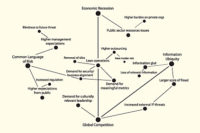This is a true story. Situations like this are seen in companies all over the country all too frequently, and they sometimes end in workplace violence and other security-related incidents. It’s interesting how often investigations into these events after the fact uncover indicators of potentially violent behavior in the files of multiple corporate departments, clues that could have triggered actions to reduce risk of an incident if they’d only been shared.
Workplace violence prevention is not just about a training program or awareness or creating a policy. It depends upon the creation of a culture of understanding and cooperation between departments and a strong process of overall risk identification and mitigation. This also applies to other efforts to protect company employees, leaders and customers, including the executive protection program and protection from activists, thieves, troubled persons and malicious criminals.
Workplace violence is only one piece of the larger puzzle of protecting people at risk. If an organization views its various people protection efforts under a single umbrella, it will have a better chance of leveraging the information and resources of all departments to provide better protection in a holistic manner. The intent is to create all-hazards planning and response when protecting people.
Here are some basic guiding principles for protecting people at risk:
1) First and foremost, identify all the people that can be at risk, all the reasons they can be at risk, and all the people, groups and situations that can put them at risk. Supervisors, executives, labor relations employees, benefits staff, HR staff, attorneys and “gatekeepers” – receptionists, security guards and administrative assistants – are all classes of at-risk people. Carefully consider why each group may be at risk. For instance, benefits staff may be at risk if an employee dies early and the family blames the company, HR staff may be at risk because they regularly deal with people in crisis, and gatekeepers because they are simply the first people a troubled person may encounter. Who is putting these people at risk? Other employees, outside environmental, political or religious extremists, criminals, domestic partners, troubled individuals suffering from mental or medical health problems, etc.
2) Identify all the sources of information on the risk or people.Each department could be a source of information and may have a record of risk-enhancing behaviors or issues. Establish a cross-functional team that may include HR, Legal, business units, Employee Assistance, Corporate Security/IT Security, Site Management and Benefits to make sure you’re getting and sharing all the information available. Have a program in process in place to gather relevant information on risks and at-risk groups.
3) Have a program that addresses the issues at all stages of risk.There are many ways you can intervene to protect people at risk, throughout the course of the threat. Make sure you have a plan for proactive action; prevention and planning; reactive action in the case of imminent danger; and emergency response and business continuity in the case of an event. The full continuum of risk has to be addressed.
4) Have resources in your toolkit to deal with the threat and the risk.Identify potential solutions for people protection issues and develop a process by which your cross-functional team will escalate and apply these solutions. If you are national or global, make sure you have resources that can cover your entire operation. Wherever you have people, you have to be able to respond and address the threats.
5) Keep data and metrics that help you define, measure, and communicate the value of what you’re doing, especially on the preventive side.
Protecting people at risk is one of the security professional’s most important functions. Leverage the resources and information of a cross-functional team to improve protection and guard against future events.



